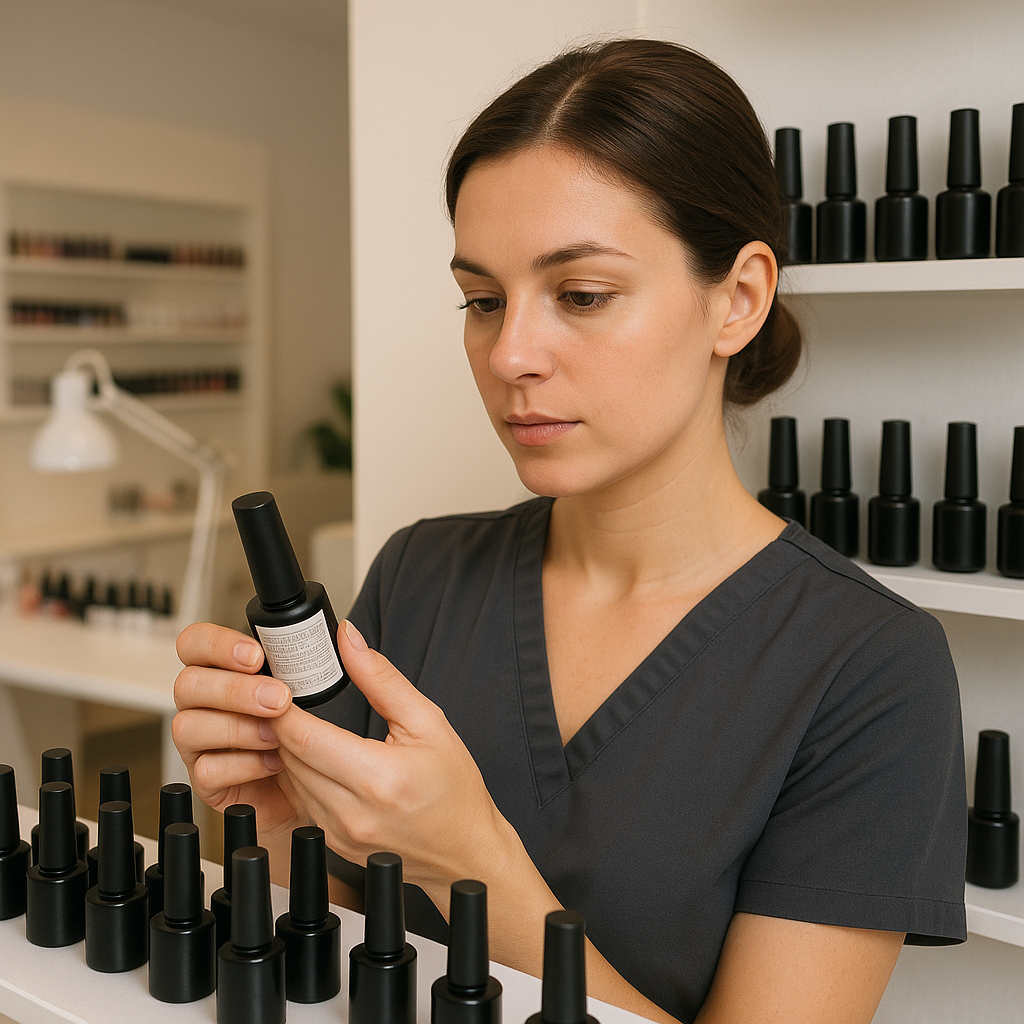Upcoming TPO Ban – Practical Information - Updated

TPO will be banned from September 1st 2025 - act now
Table of contents
1. Why Is TPO Being Banned?
As of September 1st, 2025, the European Union will prohibit the use of TPO (Trimethylbenzoyl Diphenylphosphine Oxide) in cosmetic products, including UV-curable nail gels. TPO is a photoinitiator, a chemical that enables gel products to harden when exposed to UV or LED light. It’s widely used in nail gels because it ensures fast curing, even in highly pigmented products.
However, in recent years, the safety of TPO has come under scrutiny. Under EU Regulation (EC) No 1223/2009, substances classified as Carcinogenic, Mutagenic, or Reprotoxic (CMR) are not allowed in cosmetic products unless an exemption is granted. TPO was recently reclassified as a Category 1B CMR due to toxicological evidence suggesting possible long-term health effects, particularly concerning reproductive toxicity.
The EU applies a precautionary principle in regulating cosmetics. Even if the actual risk to end users like nail technicians or clients may be low when used correctly, the legal classification leaves no room for exceptions. As a result, TPO has been added to Annex II (Prohibited Substances) of the EU Cosmetics Regulation, and from 1 September 2025, it will be completely banned in all cosmetic products on the EU market.
2. Impact on the Nail Industry
The upcoming TPO ban is causing significant shifts in the nail industry, both for manufacturers and professionals.
Some brands—particularly those with a strong EU presence—have already reformulated their gel products to remove TPO. These early movers often display “TPO-Free” on their packaging or product descriptions as a sign of compliance and safety awareness.
However, many US, UK, Korean, and non-EU brands have not reformulated their nail gels. In some cases, this is because the EU represents a relatively small portion of their global market. Reformulating a product is costly and time-consuming, especially for lines with hundreds of shades. As a result, certain popular gel systems and colors will be phased out or discontinued within the EU, leaving nail technicians scrambling for alternatives.
Other brands are in transitional phases—still developing and testing TPO-free formulations. This has created uncertainty in product availability. Stock levels fluctuate, restocks are delayed, and it’s difficult for professionals to know which products will remain legally available after the ban.
3. Understanding the Key Dates and Compliance Scenarios
It’s essential for nail technicians, salon owners, and distributors to understand the legal implications of the upcoming ban on TPO (Trimethylbenzoyl Diphenylphosphine Oxide) in cosmetic products under Annex II of Regulation (EC) No 1223/2009.
a) Products Manufactured Before 1 September 2025
These products may be legally sold until 31 August 2025. However, use will be prohibited after 31 August 2025, regardless of the manufacture date. This is because EU law does not permit the professional use of cosmetic products that contain ingredients listed in Annex II (prohibited substances), even if the product was legally placed on the market prior to the ban.
b) Products Manufactured As of 1 September 2025 That Contain TPO
These products are strictly prohibited in the European Union. They cannot be manufactured, imported, sold, gifted, distributed, or used in any setting—professional or personal.

4. What This Means in Practice
For our customers, this means that any products containing TPO will be phased out by August 2025. We no longer restock TPO containing products after April'25 - phasing out remaining products. We will stop certain brands as their products contain TPO, for other brands, with a mixed portfolio, we will remove all TPO containing products from our catalog.
We strongly advise against trying to obtain TPO-containing products from outside the EU after the ban comes into force. Under EU Regulation (EC) No 1223/2009, it is strictly prohibited to place such products on the EU market as of 1 September 2025. This includes importing, selling, gifting, distributing, or using them professionally. Nail technicians who continue to use or stock non-compliant products may face enforcement actions, including product seizure, fines, or reputational damage.
If you are inspected by the authorities, you may be required to provide documentation demonstrating compliance—such as purchase records, ingredient listings or safety data sheets, batch numbers, and manufacture dates.
5. Transition Support and the Road Ahead
We understand that the transition away from TPO is frustrating. Some of your favorite products may become unavailable. You may not yet trust the reformulated alternatives. But the industry is adapting—and so should we.
If you have questions please reach out so we can see how we can help, with information, with alternatives TPO-free products,...
6. Here’s how you can prepare:
-
Start testing TPO-free products now: Don’t wait until the last minute. Trial alternatives on yourself or trusted clients so you’re confident by September.
- Check your stock for TPO and see what you can still use before September. If you have any questions regarding products you can reach out to us.
-
Keep detailed stock records: Track which items you bought for TPO, when, and from whom. Document the manufacture date or expiration date if available.
-
Educate clients: Let them know you’re staying up to date with EU regulations and only using products that meet the latest safety standards.
7. Background Info
(*) Trimethylbenzoyl Diphenylphosphine Oxide (TPO) has been officially reclassified by the European Chemicals Agency (ECHA) from a Category 2 reproductive toxicant (Repr. 2; substances suspected of impairing fertility) to a Category 1B reproductive toxicant (Repr. 1B; substances presumed to have adverse effects on fertility or reproduction based on animal studies). This upgrade in classification reflects stronger toxicological evidence obtained from animal studies, indicating that TPO may damage fertility and is also suspected of potentially harming the unborn child at higher exposure levels.

Consequently, under EU Regulation (EC) No 1223/2009, substances classified as Carcinogenic, Mutagenic, or Reprotoxic (CMR Category 1A or 1B) are strictly prohibited from use in cosmetic products unless explicitly exempted. Although acute toxicity studies have indicated relatively low immediate health risks (oral and dermal toxicity), repeated-dose and reproductive toxicity studies demonstrated significant adverse effects, particularly reproductive harm at higher dosages. This has led the EU to adopt a precautionary approach and mandate TPO’s removal from cosmetic products, including UV-curable nail gels.
References:
- European Chemicals Agency (ECHA). Substance Information: Diphenyl(2,4,6-trimethylbenzoyl)phosphine oxide (CAS No. 75980-60-8). https://echa.europa.eu/substance-information/-/substanceinfo/100.157.565
- Cosmetic Ingredient Review (CIR). Safety Assessment of Diphenyl(2,4,6-trimethylbenzoyl)phosphine oxide. CIR Panel Report, 2019.
- European Commission. Cosmetic Products Regulation (EC) No 1223/2009. Official Journal of the European Union. https://eur-lex.europa.eu/legal-content/EN/TXT/?uri=CELEX:32009R1223
- European Union. Annex VI to Regulation (EC) No 1272/2008 (CLP Regulation) – Table 3: Harmonised Classification and Labelling. Entry for CAS 75980-60-8. https://eur-lex.europa.eu/legal-content/EN/TXT/?uri=CELEX:32023R1435
- Scientific Committee on Consumer Safety (SCCS). Opinion on the Safety of Trimethylbenzoyl Diphenylphosphine Oxide in Cosmetic Products, SCCS/1628/20, 2020. https://health.ec.europa.eu/system/files/2021-01/sccs_o_245.pdf
